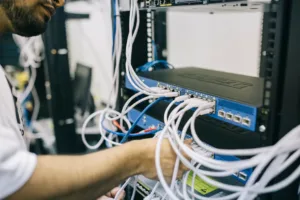A critical Server-Side Request Forgery (SSRF) vulnerability (CVE-2025-2691) has been identified in the nossrf package, affecting versions prior to 1.0.4. This flaw allows attackers to bypass SSRF protections by providing a hostname that resolves to a local or reserved IP address. With a CVSS score of 8.2, this vulnerability poses a significant risk to applications relying on nossrf for SSRF mitigation. Immediate action is recommended to upgrade to version 1.0.4 or later.
TL;DR:
- A high-severity SSRF vulnerability (CVE-2025-2691) has been discovered in the
nossrfpackage. - Versions before 1.0.4 are affected, allowing attackers to bypass SSRF protection mechanisms.
- The vulnerability has a CVSS score of 8.2 (HIGH), making it a critical concern for developers and security teams.
- Remediation involves upgrading to
nossrfversion 1.0.4 or later. - Red teams can exploit this vulnerability to test internal network access, while blue teams should prioritize patching.
Summary
CVE-2025-2691 is a high-severity vulnerability in the nossrf package, a popular tool used to mitigate SSRF attacks. The flaw enables attackers to bypass the package’s protection mechanisms by crafting malicious hostnames that resolve to internal or reserved IP addresses. This could allow unauthorized access to internal systems, data exfiltration, or further exploitation of internal services. The vulnerability was disclosed on March 23, 2025, and has been assigned a CVSS score of 8.2, indicating its high risk.
Details
The nossrf package is designed to prevent SSRF attacks by validating URLs and ensuring they do not resolve to internal or reserved IP addresses. However, versions before 1.0.4 fail to properly validate hostnames that resolve to local or reserved IP spaces, allowing attackers to bypass these protections1.
According to the National Vulnerability Database (NVD), the vulnerability arises when an attacker provides a hostname that resolves to a local or reserved IP address. This bypasses the SSRF protection mechanism, potentially enabling attackers to interact with internal systems or services2.
A proof-of-concept (PoC) demonstrates how an attacker can exploit this vulnerability. By using a hostname like localtest.me, which resolves to 127.0.0.1, the nossrf package incorrectly validates the URL as safe, allowing the request to proceed3.
Why It’s Relevant
This vulnerability is highly relevant to multiple cybersecurity roles:
- Red Teamers: Can exploit this vulnerability to test internal network access during engagements. By crafting malicious hostnames, red teams can simulate SSRF attacks to identify weaknesses in an organization’s defenses.
- Blue Teamers: Must prioritize patching and monitor for suspicious activity related to SSRF attempts. Understanding the exploit mechanism is crucial for developing effective detection rules.
- SOC Analysts: Should be aware of this vulnerability to enhance monitoring and alerting for SSRF-related anomalies.
- Threat Intel Researchers: Can track the exploitation of this vulnerability in the wild and provide actionable intelligence to their organizations.
- System Administrators: Need to ensure that all applications using
nossrfare updated to version 1.0.4 or later to mitigate the risk.
Red-Team Relevance
For red teams, CVE-2025-2691 presents a valuable opportunity to test an organization’s defenses against SSRF attacks. By leveraging this vulnerability, red teams can:
- Bypass SSRF protections to access internal systems.
- Simulate attacks that target internal APIs or services.
- Demonstrate the potential impact of SSRF vulnerabilities in real-world scenarios.
This vulnerability is particularly useful in engagements where internal network access is restricted, as it allows red teams to pivot through vulnerable applications.
Remediation Steps
To mitigate the risk posed by CVE-2025-2691, organizations should:
- Upgrade
nossrf: Ensure all applications using thenossrfpackage are updated to version 1.0.4 or later4. - Implement Additional Protections: Use network-level controls to restrict outbound requests from applications to internal or reserved IP addresses.
- Monitor for Exploitation: Deploy detection rules to identify suspicious SSRF attempts, such as requests to internal IP addresses or unusual hostnames.
- Conduct Security Audits: Review applications for potential SSRF vulnerabilities and ensure proper input validation is in place.
Conclusion
CVE-2025-2691 highlights the importance of robust SSRF protection mechanisms and the need for continuous monitoring and patching. With a CVSS score of 8.2, this vulnerability poses a significant risk to organizations using the nossrf package. By upgrading to version 1.0.4 and implementing additional safeguards, organizations can mitigate the risk of exploitation. For red teams, this vulnerability offers a valuable tool for testing defenses, while blue teams must remain vigilant in their response efforts.
References
- National Vulnerability Database. (2025). CVE-2025-2691 Detail. NIST. Retrieved March 23, 2025.
- Snyk. (2025). Nossrf Vulnerability. Snyk Vulnerability Database. Retrieved March 23, 2025.
- Snyk. (2025). Server-Side Request Forgery (SSRF) Affecting Nossrf. Snyk Vulnerability Database. Retrieved March 23, 2025.
- Snyk. (2025). How to Fix Nossrf Vulnerability. Snyk Vulnerability Database. Retrieved March 23, 2025.




